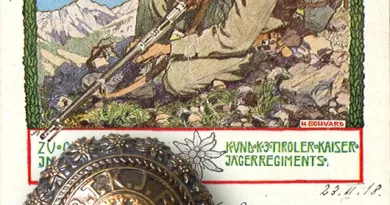7th Army
The badge of the Austro-Hungarian 7th Army is again a common badge, it is included in every collection. On the postcard selected as the background for the post, the smaller badge is exhibited, the other one is the larger (regular) version. Like all army insignia, this one was made in very large numbers, according to the inscription in 1915. The portrait of the ruler in the middle of a badge resembling a German iron cross is the main motif.

What is worth knowing about the 7th Army is that it was formed in May 1915 from the former Pflanzer-Baltin Army Group. The reason for this mixing was a disturbance in the command during the mobilization. A significant part of the army mobilized against Serbia was redirected back to the northern front, which opened in the meantime. The troops got mixed up and arrived at the front at different times, so new formations were created from the just available troops. One of these was Pflanzer-Baltin’s army group along the Dniester in September 1914, composed mainly Landwehr units, from which the 7th Army was formed in May 1915.
In the winter of 1914-15, the army group successfully defended Bukovina, relieving the right wing of the 3rd Army fighting in the Carpathians. After the Gorlice breakthrough, the left wing of the 7th Army was involved in the persecution of the Russians. The Bukovina front remained on the Dniester line. In 1916, the 7th Army suffered a heavy defeat in the Bruszilov Offensive. Bukovina was evacuated. Pflanzer-Baltin was then replaced by Karl von Kirchbach. By September 1916, the front had stiffened again, but only on the Carpathian line. In 1917, the 7th Army defended the Carpathian line from the borders of Maramures to Kirlibaba and Dorna Watra. The troops were a mix of German and Austro-Hungarian units (German Karpathenkorps, 17th and 11th Austro-Hungarian corps). In the summer of 1917, through the counterattack of the Central Powers, the Russian troops were again expelled from Bukovina. After peace with the Russians, in the spring of 1918, several units of the 7th Army were redirected to the hinterland and entrusted with crop collection.




